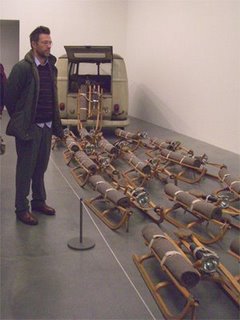|
|
| home | features | exhibitions | interviews | profiles | webprojects | gazetteer | links | archive | forum |
|
The Pack: 1969 - 2008
Volkwagen first made cars in Germany in the
30s on the orders of Adolf Hitler who had originally asked Porsche to
design an affordable and economical German family car. The first
Volkswagen, or 'Peoples Car', looked very much like the Beetles that
went on to become best-selling cars throughout the 60s and 70s.
The success of the Volkswagen company is for many a symbol of the success of the post-war German economy, especially poignant considering that when British and American companies had the opportunity to buy the Volkswagen factories for next to nothing after the war they had turned them down as being too much of a liability. In 1969, Joseph Beuys used the VW campervan in a substantial installation: the Pack. Beuys was then at the height of his powers. His first performance had been 'Explaining Pictures to a Dead Hare' in 1964? and his profile in Europe had been growing since then, such that he was about to have his first big show in Britain, courtesy of Richard DeMarco in Edinburgh. Beuys' camper van had red crosses painted on its sides such that whilst being a symbol of modern Germany, and indeed the modern German family, it also resembled an ambulance. Instead of children or abmulance men, however, it had sledges with rolls of felt, lard and a torch strapped to them: materials that might help someone survive in adverse weather conditions, as Beuys is reputed to have done after being shot down in the Urals whilst seeing action with the Luftwaffe during the war. Much of Beuys' work related to this wartime experience and his perceptions of Germany, and indeed the West, as traumatised or wounded and in need of spiritual healing. Revered by many in Europe, and hugely influential in Germany, he was not so well received in America contrary to the title of one of his most famous works: 'I like America and America likes me' a performance from 1974. Benjamin Buchloh and Lucy Lippard were critical of his work suggesting that...
Whilst to Germans, and to many others the Volkwagen is a symbol of modern Germany, it is also an important symbol of surf culture. The VW campervan is still favoured by surfers, as a cheap mode of transport, large enough to sleep in and carry surfboards. It appeared famously in...and since in.... Interestingly this symbolism, like much of surf culture, (and by the same token skateboarding and BMX), belongs to the late 20th Century to a generation not immediately touched by the traumas of the two World Wars. Perhaps this is why Ben Cooks remake of the Pack in 2008 has a lighter, sunnier disposition. Instead of being burdened with Beuys' angst it has optimistic playful quality. It seems to suggest, absurdly, that in the 21st Century leisure sports, like surfing, have healed the traumas of the past, or more cynically that they are as likely to as art is.
|
|
|

 Beuys
is however one the most influential artists of the 20th Century:
important for the way in which he strove to invest rather ordinary
commonplace materials with meanings far beyond the everyday. Following
his example sculpture became more theatrical and more metaphorical,
and the boundaries between installation, sculpture and performance
became redrawn.
Beuys
is however one the most influential artists of the 20th Century:
important for the way in which he strove to invest rather ordinary
commonplace materials with meanings far beyond the everyday. Following
his example sculpture became more theatrical and more metaphorical,
and the boundaries between installation, sculpture and performance
became redrawn.